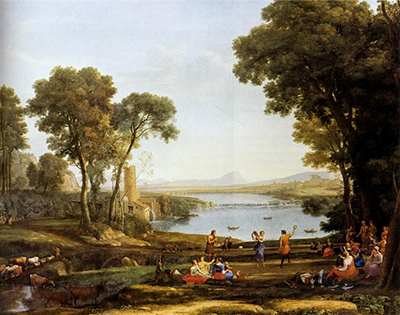Landscape with the Marriage of Isaac and Rebecca was a part of a pairof paintings produced by Claude Lorrain in around 1648. The sister piece was the more famous Seaport with the Embarkation of the Queen of Sheba.
The painting features a flurry of active figures in the foreground which immediately draws us to the title of Landscape with the Marriage of Isaac and Rebecca. Behind them we then see a landscape view of incredible beauty, with a wide river leading towards a number of mountains in the far distance. A bridge can be seen adding some interest on the horizontal angle, stretching across this wide expanse of water. Typical for the artist, the sky cuts across the horizon and dominates the entire top half of the work, though without much detail within it other than for the odd cloud here and there. The brightness added here then shines across the rest of the work, other than where shadows are created by the taller trees. It is certainly a stunning artwork, though follows a formula which Claude developed in the early stages of his career. As patrons started to commission more artworks, he could stick fairly closely to this pattern, ensuring financial survival, if a little at the expense of his creative instincts.
The story behind the marriage of Isaac and Rebecca comes directly from the Old Testament book of Genesis. A careful inspection of this piece reveals all manner of excitement and celebration to mark this occasion. There is dancing, whilst others rest and relax. The style of this landscape is believed to have been inspired by the Roman countryside, and Claude would spend most of his working life within the city of Rome. It was the Duc de Bouillon who commissioned this painting but over time it would become a part of the collection of the National Gallery in London and was actually one of the first items to be found here in the early 19th century. It remains there today and sits alongside a number of other paintings from the very same artist, who is understood to have been particularly influential on the rise of landscape painting within the UK, as a direct result of some of these acquisitions.
A drawing remains within the Royal Collection in the UK under the title of A landscape with a dance and this is believed to have been a preparation for the oil work displayed here. Claude regularly worked in this manner and some of his pen and wash works were highly detailed. One can see clear similarities between the compositions, though also some amendments in the oil version, where greater detail in the foreground was added. Interest in the artist's drawings has remained strong over the past few centuries and he was unusual in how accurately and diligently he documented many of these sketches, as most artists would just leave them around without much care or thought. This has been reflected in their respective valuations and art historians have also found them to be useful in charting out his career over time, considering how many centuries have passed since Lorrain first excited European art collectors.




